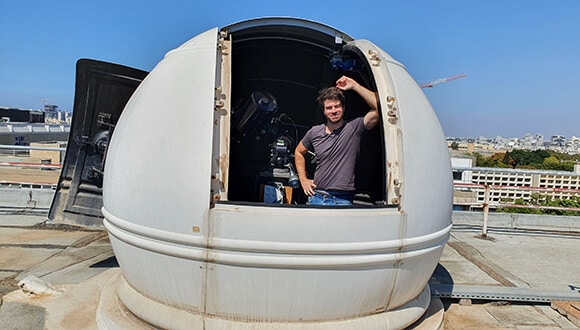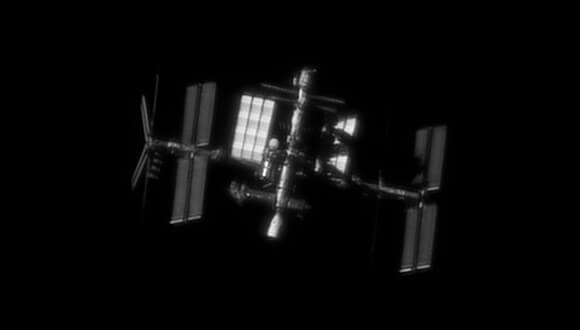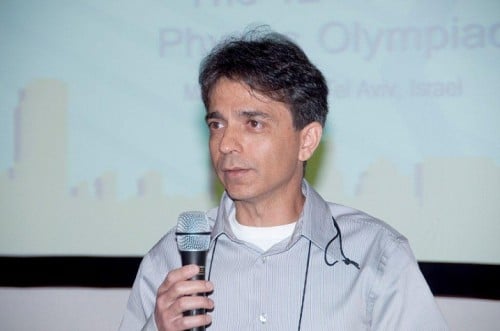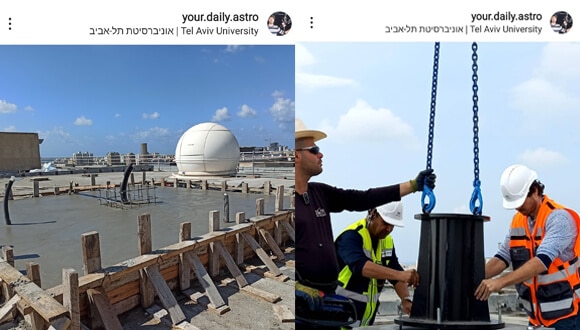The new observatory of planets and satellites that is currently being built on the roof of the Shenkar building will become one of the most sophisticated laboratories in the world, which will allow, among other things, advanced communication with satellites and other spacecraft

Anyone who wants to know where the receivers are directed at the International Space Station or how the nano satellite of Tel Aviv University is doing, TAUSAT1, who has been circling the Earth for nearly a year, will be able to see it with his own eyes very soon. These days, a building is being built on the roof of the Shankar School of Physics and Astronomy at the Faculty of Exact Sciences by Raymond and Burley Sackler, a new and sophisticated optical ground station, which can, among other things, provide a glimpse of the very small details that take place very high above us.
And what else will it be used for? It will mainly follow nanosatellites and relatively close celestial bodies, but also stars that are millions of light years away from us. In the future, the station will serve as a tool for quantum encryption through space, one that will allow us to encrypt any type of information in the best possible way without being able to hack into it, and to collect important scientific information. Just before the most sophisticated telescope in Israel starts working with us, we caught Prof. Yaron Oz, head The quantum center, Prof. Haim Suchovski from the School of Physics and Astronomy and Michael Tzukran, an international star photographer and the one who will operate the new station, for a light conversation about quantum optical communication, space photography and unplanned encounters that led to groundbreaking projects.


Let's start from the roof and go down
Prof. Haim Suchovski is engaged in basic and applied research in the broad field of research on the interaction between light and matter. "My research laboratory mainly deals with nanophotonics, super fast dynamics and non-linear interaction of light with different materials in nature. In recent years, I have also participated in the intensive activity At the nanosatellite center And in the new quantum center that started operating on campus, where what we are doing now on the roof is a combination of all these things together", he explains.
"If once the field of space 'belonged' exclusively to NASA and very specific entities, such as the aerospace industry here in Israel - today even high school students send satellites into space," explains Suchovski. the revolutionnew space which allows private companies to send nano-satellites into space at a relatively reasonable cost has changed our lives, and in the last 15 years universities have also been doing it.
You Nano satellite TAUSAT1, characterized and built here on campus under the leadership of Dr. Meir Ariel, Prof. Ofer Amrani From the Ivy and Alder Fleishman Faculty of Engineering and Prof. Colin Price from the Porter School of Environment and Earth Sciences, launched by Tel Aviv University about a year ago. Prof. Suchovski says that part of the project so far has been to build a standard radio ground communication station, which will communicate with the launched satellite containing scientific experiments. "One of the next projects we want to do is to create optical communication through space, and later quantum optical communication through space, which is a new and developing field in itself."
Encrypting information from space
Information encryption is an important subject with many applied meanings and quantum mechanics changes the rules of the game in this subject. "Today we encrypt our information relying on the complexities of complex mathematical problems, and assume that computers need a long time to solve these problems and therefore the encrypted information is protected," explains Prof. Yaron Oz, head of the Tel Aviv Quantum Center. "Quantum computers are based on a different computational paradigm and can change the picture. For example, the problem of decomposing a whole number into its initial factors, whose complexity prevents encryption algorithms that are widely used today, will be quickly solved by a quantum computer. Therefore, there is an understanding that it is important to characterize what the protected encryption methods will be in the age of quantum computers."
"On the other hand, the quantum systems have exceptional encrypted information transfer capabilities due to the fact that quantum mechanics does not allow information to be copied, and any attempt to copy or change it results in the destruction of the original information. This means that a quantum communication line is completely safe from eavesdropping. The transmission of an encryption key in a quantum communication network is completely secure, and indeed quantum optical encryption already exists using optical fibers," he says.
It turns out that this encryption is possible, but limited to a distance of 150-200 km. "This means that if we want to encrypt a quantum communication network from Tel Aviv to Haifa, it is possible, but we will not be able to transmit encrypted information from here to Eilat." According to Prof. Oz, financial sectors in Switzerland already use such communication networks, but transferring information between continents, for example from New York to London in this way is not possible. We'll have to trust him on this one.

Prof. Oz says that the first to succeed in encrypting information in a satellite quantum communication network were the Chinese, about four years ago, and this, as expected, provoked many echoes around the world, especially in the US and Europe. "Even in Israel there is an understanding of the need to move forward in this direction, and at Tel Aviv University we decided to take steps at the executive and research level. Our new laboratory with the telescope on the roof is going to take part in the future satellite project of the Center for Nanosatellites".
The new observatory is going to be very professional, accurate and sophisticated. With the help of various bodies at the university, and especially with the support of the Quantum Center and the support of Prof. Erez Etzion, Head of the School of Physics and Astronomy, the budget and space for building the observatory and buying the massive equipment was raised. It is a huge, accurate robot with a 24-inch looking telescope, which can track stars, galaxies, nebulae and other bodies. The robot, which weighs 300 kg, can move at an angular speed of up to 50 degrees per second and accurately track satellites moving at a low altitude, as well as lower aircraft. "Already today we are doing preliminary experiments in optical communication, and with the level of precision of the new telescope we will be the only ones in Israel with such equipment", promises Prof. Suchovski.
The librarian of the stars
At this stage, and completely by chance, another player entered the picture, who helped Prof. Suchovski to leverage the idea into execution: Michael Tzukran, a world expert in astronomical photography and satellites and a consultant in the construction of a research observatory.
"As a seasoned star photographer, I wanted to challenge myself and photograph the International Space Station. I needed an open roof, which would be close to the orbit of the space station as it passes over the sky of Israel. And I simply asked if it was possible to do it here." Michael arrived with his personal equipment and took one of the detailed pictures taken from Earth of the space station. Recall that at the time of the photo the space station was flying at a speed of nearly 28 km/h. in the small
Michael's specialty is to calibrate and control the sophisticated robot, track the satellites and photograph them according to the researchers' request. With the new equipment, he promises that he intends to record satellites as never seen from Earth before.
Prof. Adi Aryeh from the Faculty of Engineering and the doctoral students Dolev Bashi, Giorgi Geri Rosenman, Yonatan Pyatecki, Sahar Shaf, Tomer Nahum and Yuval Raks are also working on the establishment of the technological system for quantum optical communication in the laboratory.
Prof. Suchovski estimates that in the future there will be all kinds of industries, defense and other, that will be happy to use the new platform, including other universities. "This is a national resource. Some of the knowledge learned about the system is shared with other academic institutions, such as the Hebrew University, for example, which, under the leadership of Prof. Hagai Eisenberg and Prof. Yaron Bromberg, established the national demonstration of a fiber-based quantum communication system and recently completed the construction of a mobile optical ground station. I believe that all of this can be used by us to promote applied and basic research in the State of Israel and in the world," he concludes.
